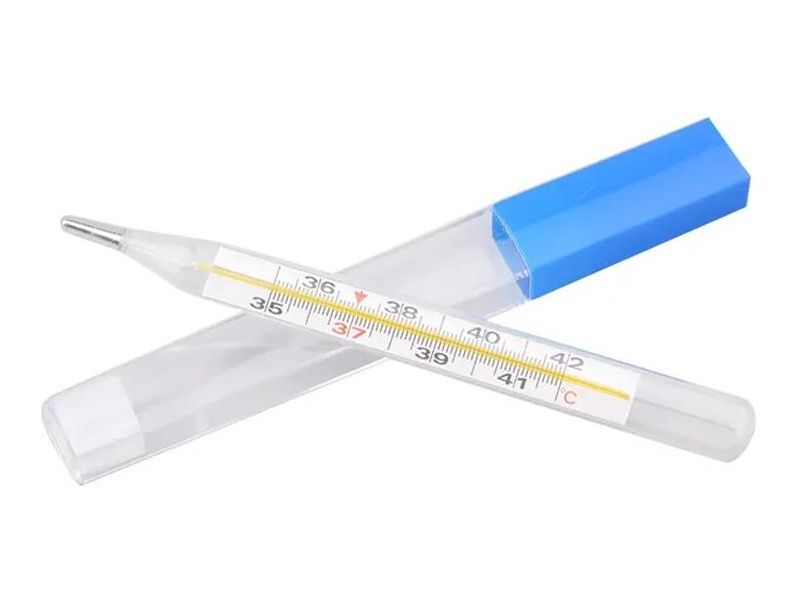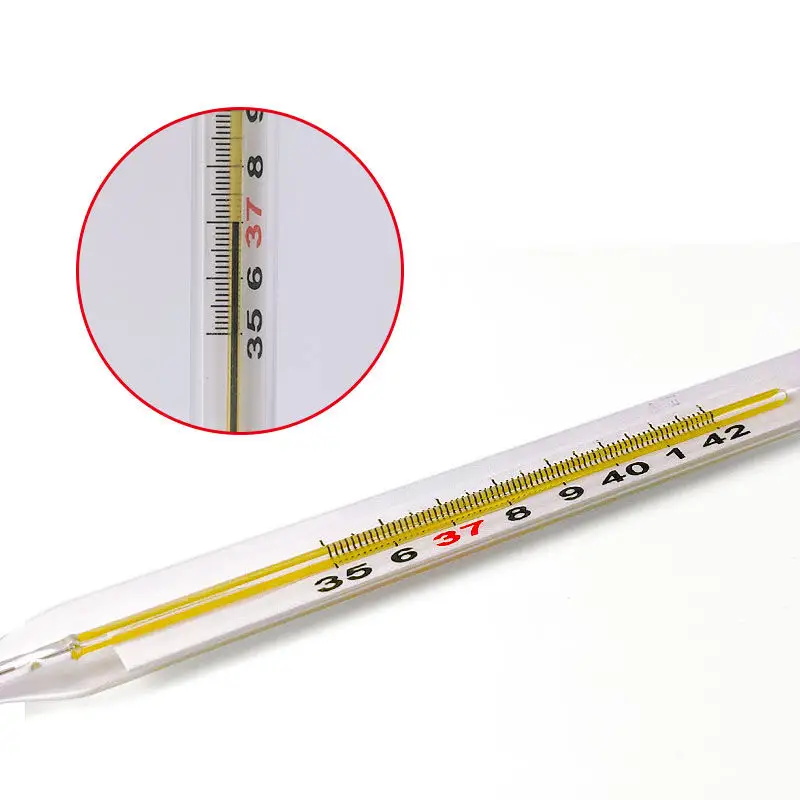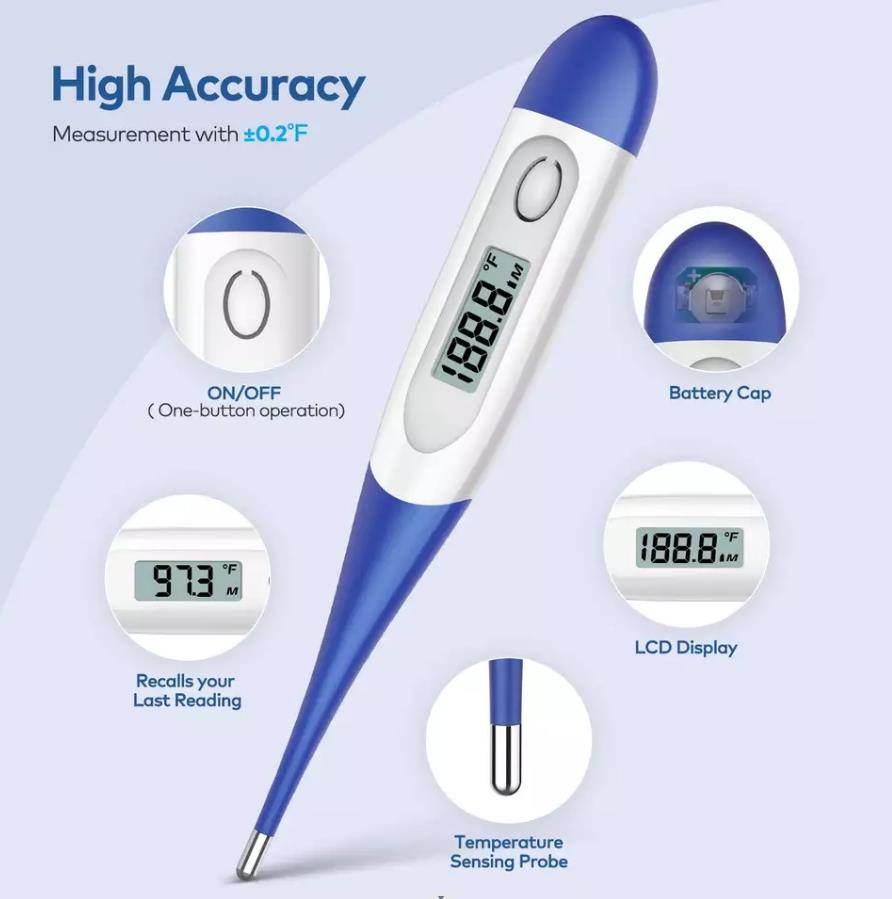With so many different types and brands of thermometers on the market, finding the right one can be overwhelming. In this guide, we’ll provide you with all the information you need to choose the best thermometer for your needs.
Thermometer Knowledge
Contact vs Non-Contact Thermometers
Thermometers can be categorized into two main types: contact and non-contact thermometers. Contact thermometers require physical contact with the object or surface being measured, while non-contact thermometers can measure temperature without making contact.

Contact thermometers include traditional glass thermometers and electronic thermometers. They work by using a probe to come into direct contact with the object or surface being measured. The probe then measures the temperature and displays it on a digital or analog screen. These types of thermometers are commonly used for oral, rectal, or underarm temperature readings, and are also useful for measuring the temperature of liquids.

Non-contact thermometers, on the other hand, use advanced technology to measure temperature without making contact. Infrared ear thermometers, infrared forehead thermometers, and infrared screening instruments are some common examples of non-contact thermometers. These thermometers work by emitting infrared radiation, which is absorbed by the object or surface being measured. The thermometer then calculates the temperature based on the amount of infrared radiation absorbed.
Contact thermometers require physical contact with the object or surface, which can be inconvenient or even impossible in some situations. Non-contact thermometers, on the other hand, can measure temperature from a distance without disturbing the object or surface being measured. Non-contact thermometers are often faster and easier to use than contact thermometers and are ideal for use in situations where hygiene and safety are a concern, such as in hospitals, schools, and public spaces.
Types of Thermometers

Traditional Glass Thermometers:
The traditional glass thermometer is the oldest and most common type of thermometer. It consists of a glass tube filled with a liquid, typically mercury or colored alcohol, that expands as the temperature increases. The thermometer is placed under the tongue or in the armpit for a few minutes to get an accurate reading. Although they are simple and inexpensive, glass thermometers can be fragile and hazardous if broken, especially if they contain mercury.

Mercury-Free Glass Thermometers:
Mercury-free glass thermometers are similar to traditional glass thermometers but use colored alcohol or other fluid instead of mercury. These thermometers are considered safer than mercury thermometers because they do not contain toxic substances. They work by the same principle as traditional glass thermometers, with the fluid inside the glass tube expanding or contracting as the temperature changes.

Electronic Thermometers:
Electronic thermometers are more modern and advanced than traditional glass thermometers. They use a thermistor or other electronic component to detect temperature changes and give faster and more accurate readings. Electronic thermometers come in various forms, such as digital oral or rectal thermometers, and infrared thermometers. They are easy to use, compact, and usually have large, easy-to-read displays.

Infrared Ear Thermometers:
Infrared ear thermometers, also known as tympanic thermometers, are commonly used in medical settings. Tympanic or infrared ear thermometers are a popular choice in healthcare settings because of their ability to precisely measure temperature by detecting the infrared radiation emitted by the eardrum.
The thermometer is gently inserted into the ear canal, and a reading is taken in a matter of seconds. These thermometers are fast, accurate, and comfortable for the patient, but they may not be suitable for use in young children or people with ear infections.

Infrared Forehead Thermometers:
Infrared forehead thermometers are non-contact thermometers that measure the infrared radiation emitted by the skin on the forehead. They are easy to use and do not require any physical contact with the patient. These thermometers are suitable for use in both adults and children, but their accuracy can be affected by factors such as sweating or hair on the forehead.

Infrared screening instrument:
Also known as a thermal imaging camera or temperature gun, is a medical device that uses infrared technology to measure body temperature. It works by capturing the infrared radiation emitted by the body and displaying it as a thermal image on a screen.
The device can differentiate and judge temperatures by color, and it alarms when the temperature exceeds a predetermined threshold. It also automatically captures images at the same time, allowing for quick and convenient screening of individuals with abnormal body temperatures.
The infrared screening instrument has two display modes: visible light display and thermal image display. The visible light display can identify the appearance of the measured person and display the temperature value, while the thermal image display shows the highest and lowest temperature of the body surface. These instruments are available in handheld, fixed, and mobile versions, making them versatile and suitable for various settings.
How Do Thermometers Work?
Thermometers work by measuring the temperature of an object or environment. There are several types of thermometers, including mercury, digital, infrared, and more.
Mercury thermometers work by using the principle of thermal expansion. The mercury inside the thermometer expands as it is exposed to heat, causing the liquid to rise up the calibrated tube.
Digital thermometers make use of electronic sensors to gauge temperature accurately. They often come with a digital display that shows the temperature reading, making them easy to read and use.

Infrared thermometers, also known as non-contact thermometers, use infrared technology to measure temperature from a distance. Non-contact thermometers are perfect for taking the temperature of objects that are hard to reach or may be dangerous to touch, such as hot surfaces or moving parts.
Each type of thermometer has its own unique way of measuring temperature, making it important to choose the right type of thermometer for the intended use. For example, a digital thermometer may be better suited for measuring body temperature, while an infrared thermometer may be better suited for measuring the temperature of food or surfaces.
Accuracy and Precision of Thermometers
When it comes to the accuracy and precision of thermometers, it’s important to consider the type of thermometer being used. In reality, glass thermometers are typically more accurate. This is because the liquid in a glass thermometer expands and contracts more uniformly than the thermistor or other electronic component in an electronic thermometer, resulting in a more precise measurement.

However, it’s worth noting that infrared thermometers are also highly accurate and can provide quick and convenient temperature readings without the need for contact. While they may not be as accurate as glass thermometers, they are still highly precise and are often used in medical settings for this reason.
For medical applications where precise temperature measurements are crucial, a glass thermometer may be the best choice. However, for quick temperature checks in non-medical settings, an infrared thermometer may be a more practical option.
Applicable Crowd Analysis
When it comes to temperature measurement, it’s important to consider the applicable crowd. Different age groups and individuals with special needs may require different methods of temperature measurement to ensure accuracy.

Babies and children, for example, may be more sensitive to invasive methods such as rectal or oral thermometers. Non-contact infrared forehead or ear thermometers can be a less invasive and more comfortable choice for this group.
Adults may be able to use a wider range of thermometers, but may still prefer non-contact options for convenience and speed.

Elderly people may require special consideration due to age-related changes in skin temperature regulation. In some cases, rectal or oral thermometers may be the most accurate option for this group.
Overall, it’s important to consider the applicable crowd when choosing a thermometer and method of temperature measurement to ensure accuracy and comfort for the individual being tested.
Price Analysis
When it comes to purchasing a thermometer, the price can vary greatly depending on several factors.
Factors that Affect Thermometer Prices:
Type of thermometer: As previously discussed, there are several types of thermometers available, and each has its own price range.
Features: Some thermometers come with additional features such as backlit displays, memory storage, and audible alarms, which can increase the price.
Brand: Well-known brands may come with a higher price tag than lesser-known brands.
Accuracy: Higher accuracy may come at a higher cost.
Average Price Ranges for Different Types of Thermometers:
Traditional glass thermometers: These are typically the least expensive option and can cost anywhere from $1 to $ 5.
Mercury-free glass thermometers: These can cost slightly more than traditional glass thermometers, with a price range of $2 to $10.
Electronic thermometers: These can range from $5 to $20, depending on the features included.
Infrared ear thermometers: These tend to be more expensive, with a price range of $5 to $50.
Infrared forehead thermometers: These can range from $10 to $200, depending on the features included.
Infrared screening instruments: These tend to be the most expensive option, with a price range of $100 to $10,000 depending on the size, features, and intended use.
Cost vs Value: What to Consider
When considering the cost of a thermometer, it is important to also consider the value it provides. A more expensive thermometer may offer more features or higher accuracy, which could be valuable in certain situations.
Global Market Analysis
The global thermometer market has experienced significant growth in recent 10 years. The market is driven by various factors, including the increasing incidence of infectious diseases, the growing demand for home healthcare devices, and the rising awareness of healthcare and personal hygiene.
Key market players in the thermometer industry include Omron Healthcare, Exergen Corporation, Braun GmbH, and Terumo Corporation. These companies are constantly developing new thermometer products and medical technologies to meet the changing demands of the global market.
In terms of regional market analysis, North America dominates the global thermometer market due to the increasing prevalence of chronic diseases, the aging population, and high healthcare expenditure.
Europe and Asia-Pacific regions are also significant markets, driven by the growing demand for non-invasive and accurate temperature monitoring devices.

Emerging market trends in the thermometer industry include the increasing use of smart thermometers and wearable devices that allow for continuous temperature monitoring and the development of non-contact thermometers that can measure temperature from a distance. Furthermore, the COVID-19 pandemic has led to a surge in demand for thermometers, particularly infrared thermometers, for screening individuals for fever in public places.
How to Choose the Best Thermometer
When it comes to choosing the best thermometer, there are several factors to consider. Firstly, you should determine the purpose of the thermometer. Is it for personal or medical use? Next, consider the applicable crowd, such as babies, children, adults, or elderly people. You should also review the price and budget to ensure that you get the best value for your money.
Look for reputable brands that have positive customer reviews and feedback. Additionally, evaluate product features and innovation, such as Bluetooth connectivity or temperature memory.

Lastly, compare the accuracy and precision of the thermometer. This is particularly important for medical use, where accuracy is critical. By considering these factors, you can choose the best thermometer that suits your needs and preferences.
Conclusion
Based on the analysis conducted in this report, we recommend that consumers consider the purpose of the thermometer, the applicable crowd, price and budget, brand reputation and customer feedback, product features and innovation, and accuracy and precision when choosing a thermometer.
Looking towards the future, there are exciting developments in thermometer technology. For example, some companies are developing wearable thermometers that can continuously monitor body temperature and alert the wearer if it exceeds a certain threshold. Additionally, there are efforts to integrate thermometer technology with other health monitoring devices, such as smartwatches and fitness trackers.
JINYE’s Medical Consumable Products

As an experienced manufacturer and exporter of medical instruments, we are committed to providing our overseas customers with the best products and services.
First and foremost, you can expect superior quality products. We use only the best materials and the latest technology to ensure that our thermometers meet international standards and are highly accurate and reliable.
In addition to quality, we also offer a wide range of thermometer options to meet your specific needs. Whether you need an infrared thermometer for non-contact temperature measurements or a digital thermometer for precise readings, we have the right product for you.
When you choose JINYE, you also get excellent customer support. Our team of experts is available to answer any questions you may have and to provide you with technical support whenever you need it. We are committed to ensuring that our customers are satisfied with their purchases and will go above and beyond to make sure that you are happy with our products and services.



